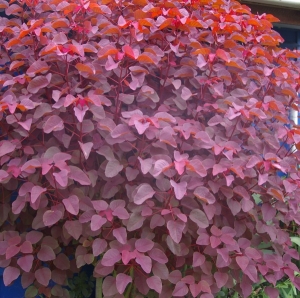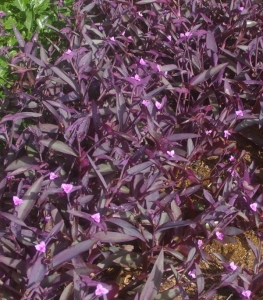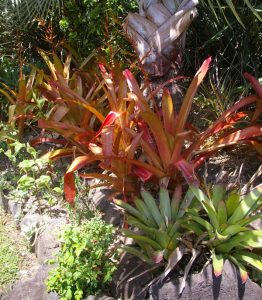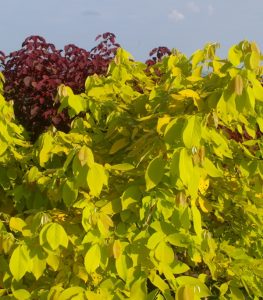Many plants have foliage with patterns of colour other than green. This attribute attract us as gardeners and plenty of these pattern-leaf plants contribute to the richness of our gardens.
However there are fewer plants carrying leaves of a single intense colour. These plants fascinate me as I wonder how they can possibly function; how they carry out photosynthesis; and why on earth they would have evolved like this. Well there is one pay off. They get propagated, nurtured and grown in gardens across the world. They get watered, fed and have competing vegetation (weeds) around them banished.
I have many of these strange plants in my garden and a few of my favourites are listed below:

Dendrolobium umbellatum ‘Vanuatu’, the Presbyterian Tree, has striking yellow foliage.
Pure yellow – Dendrolobium umbellatum ‘Vanuatu’ (Presbyterian Tree, Golden Horse Bush)
Presbyterian Tree is a large shrub or small tree with brilliant yellow trifoliate leaves. The new growth has a slight orange-yellow cast. Pea-shaped flowers, followed by pods appear on mature plants. The shrub grows quickly, is extremely hardy and is naturally quite dense, however yearly pruning will keep the plant looking immaculate.
This plant is a mutant of the common coastal tree native to Australia, the Pacific Islands, Asia and Eastern Africa. The yellow-leaved form apparently originated in the grounds of a Presbyterian Church in Vanuatu. This hardy plant has become very common in that country and is now becoming better known around the world.

Pure blood red – Euphorbia cotinifolia, or red spurge
Pure blood red – Euphorbia cotinifolia (Carribean Copper Plant, Red Spurge)
Once a popular shrub, this beautiful and hardy species has dropped from favour. Perhaps it was just too common, too easy to propagate…. and just too colourful to be tasteful. Perhaps it was the fact that the plant is poisonous (but so are so many popular garden ornamentals).
To find one of these shrubs you will have to go for a hunt. It’s not too hard to track one down as they certainly stand out in gardens. Look for it in older gardens as this plant is a survivor. It will survive long periods of dry weather and yet thrive and flourish during wet periods.
With warmth and water, the leaves get redder. Masses of fresh new growth of a deep blood red cover the shrub. During very dry weather, the plant defoliates and the older, stressed leaves take on a browner cast.

Pure purple – Tradescantia pallida ‘Purpurescens’ in my garden
Pure purple – Tradescantia pallida ‘Purpurea’ (Purple Heart)
Purple Heart is purple, an intense matt purple. I can’t think of any other plant like it. It makes a great groundcover and over summer is covered by small triangular pink flowers that are beloved by bees.
Many people are concerned about growing tradescantias, having had experience with T. pendula or T. fluminensis. Purple robe has a different growth character. It tends to come away from the rootstock annually and has more of an upright growth. While it can root and spread laterally over time, this is a slow process, and often limited by adjacent plant growth.

Pure orange Aechmea blanchetiana ‘Rubra’ glows in the garden when you find the right position
Pure orange – Aechmea blanchetiana ‘Rubra’
Aechmea blanchetiana ‘Rubra’ is a large bromeliad with brilliant orange strappy leaves. With heat, humidity, moisture and just the right position, the plant ‘glows’ orange. It also has an attractive flower spike in red and yellow that reminds me more of a grass head than a bromeliad inflorescence.
Like many bromeliads, you have to find just the right position to get the best colour. Too hot and sunny and the plants may bleach or burn during the hottest days of summer. Too shady or cool and the colour fades away. I suggest propagating a few plants and placing them in appropriate areas of the garden. When you hit the right spot move your plants there for a stunning mass planting. Beware there are many inferior hybrid plants masquerading under this name.

Dendrolobium umbellatum ‘Vanuatu’, contrasted against rich red Euphorbia foliage
When using any of these plants in the garden or a landscape, I team them up with other plants having leaves of brilliant colour, or with deep rich green foliage. You can create pools of rich colour as points of emphasis within the garden and as a contrast to areas of green. Foliage colours can also be teamed with those used on structures and buildings for dramatic effect or with flowering plants with similar colouring.
Heavy use of colour can be bold, exiting and energetic. If you want a calming, relaxing garden, these are not the plants for you!
